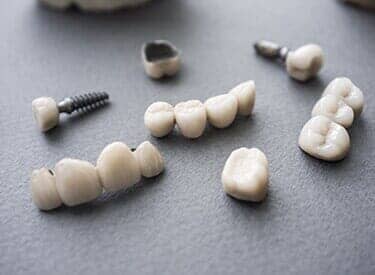Cosmetic Dentistry
DENTAL OFFICE IN VIRGINIA BEACH, VA
3i Dental Implants
There are a wide variety of dental implants
in the marketplace, but 3i have an almost unparalleled success rate. Almost 98% of 3i implants
are fitted successfully
and last for a lifetime. 3i implants contain a unique feature, which is embedded in the surface of the screw. Implant screws made by other companies are sprayed with calcium phosphate to enhance the bone integration process. However, 3i screws actually contain calcium phosphate, which means that delamination is less likely to occur.
Additionally, the cone-shaped 3i screw adds precision to the placement of implants and ensures that the final prosthesis is comfortable and can withstand pressure.
Additionally, the cone-shaped 3i screw adds precision to the placement of implants and ensures that the final prosthesis is comfortable and can withstand pressure.

Here are some of the other benefits associated with 3i implants:
- Better oral health.
- Higher success rate.
- Improved self-esteem.
- Long-lasting results.
- Multiple 3i implants can be placed during a visit.
- Natural-looking implants.
- No adhesives or mess.
- Prevention of bone loss and gum recession.
- Sturdy, functional prosthetic teeth.
How are 3i dental implants placed?
The procedure for placing 3i dental implants is similar to many other implant procedures. It is usually performed in two short visits, the first visit being typically an hour in length and the second taking around thirty m
After the dentist has analyzed the X-rays and diagnostic results, the implant root can be inserted. This procedure will be performed under local anesthetic, unless another type of sedation is preferred.

Here is a step-by-step process for the first stage of a 3i dental implant placement:
- An incision will be made in the gum tissue to expose the jawbone.
- A tiny hole will be drilled into the jawbone to insert the implant into.
- The implant will be screwed or tapped into the designated position.
- A small temporary stop-cap is placed to cover the implant, and the surgical site is sutured closed.
- After approximately 10 days, the sutures will be removed and the dentist will assess the healing process.
Generally, 3i dental implants enhance the healing process, which means that the second treatment phase can be completed around 10-12 weeks after the first.
Here is a brief overview of can be expected at the second appointment:
A local anesthetic will be administered, and a tiny incision will be made to expose the prosthetic root. The temporary stop-cap will be removed and a small post or abutment will be attached to the implant.
When the healing process is complete, the new dental prosthesis (usually a crown) will be created from bite impressions. A tiny screw will be used to secure the prosthesis onto the abutment. Any necessary adjustments will be made to ensure the prosthesis is comfortable, and the 3i dental implant will be secure for a lifetime.
When the healing process is complete, the new dental prosthesis (usually a crown) will be created from bite impressions. A tiny screw will be used to secure the prosthesis onto the abutment. Any necessary adjustments will be made to ensure the prosthesis is comfortable, and the 3i dental implant will be secure for a lifetime.
COMPOSITE FILLINGS
A composite (tooth colored) filling is used to repair a tooth that is affected by decay, cracks, fractures, etc. The decayed or affected portion of the tooth will be removed and then filled with a composite filling.
There are many types of filling materials available, each with their own advantages and disadvantages. You and your dentist can discuss the best options for restoring your teeth. Composite fillings, along with silver amalgam fillings, are the most widely used today. Because composite fillings are tooth colored, they can be closely matched to the color of existing teeth, and are more aesthetically suited for use in front teeth or the more visible areas of the teeth.
As with most dental restorations, composite fillings are not permanent and may someday have to be replaced. They are very durable, and will last many years, giving you a long lasting, beautiful smile.
There are many types of filling materials available, each with their own advantages and disadvantages. You and your dentist can discuss the best options for restoring your teeth. Composite fillings, along with silver amalgam fillings, are the most widely used today. Because composite fillings are tooth colored, they can be closely matched to the color of existing teeth, and are more aesthetically suited for use in front teeth or the more visible areas of the teeth.
As with most dental restorations, composite fillings are not permanent and may someday have to be replaced. They are very durable, and will last many years, giving you a long lasting, beautiful smile.
Reasons for composite fillings:
- Chipped teeth.
- Closing space between two teeth.
- Cracked or broken teeth.
- Decayed teeth.
- Worn teeth.
How are composite fillings placed?
Composite fillings are usually placed in one appointment. While the tooth is numb, your dentist will remove decay as necessary. The space will then be thoroughly cleaned and carefully prepared before the new filling is placed. If the decay was near the nerve of the tooth, a special medication will be applied for added protection. The composite filling will then be precisely placed, shaped, and polished, restoring your tooth to its original shape and function.
It is normal to experience sensitivity to hot and cold when composite fillings are first placed, however this will subside shortly after your tooth acclimates to the new filling.
It is normal to experience sensitivity to hot and cold when composite fillings are first placed, however this will subside shortly after your tooth acclimates to the new filling.
A local anesthetic will be administered, and a tiny incision will be made to expose the prosthetic root. The temporary stop-cap will be removed and a small post or abutment will be attached to the implant.
When the healing process is complete, the new dental prosthesis (usually a crown) will be created from bite impressions. A tiny screw will be used to secure the prosthesis onto the abutment. Any necessary adjustments will be made to ensure the prosthesis is comfortable, and the 3i dental implant will be secure for a lifetime.
When the healing process is complete, the new dental prosthesis (usually a crown) will be created from bite impressions. A tiny screw will be used to secure the prosthesis onto the abutment. Any necessary adjustments will be made to ensure the prosthesis is comfortable, and the 3i dental implant will be secure for a lifetime.
CONTACT US TODAY
Phone: 757-430-2600
Email: dora@drluma.com
Address: 1244 Perimeter Pkwy, Ste 444, Virginia Beach, VA 23454
Email: dora@drluma.com
Address: 1244 Perimeter Pkwy, Ste 444, Virginia Beach, VA 23454
HOURS OF OPERATION
| Mon-Thu | 8:30 AM - 5:30 PM |
| Fri-Sun | Closed |







Content, including images, displayed on this website is protected by copyright laws. Downloading, republication, retransmission or reproduction of content on this website is strictly prohibited. Terms of Use
| Privacy Policy
BROWSE OUR WEBSITE
CONTACT US TODAY
Phone: 757-430-2600
Email: dora@drluma.com
Address: 1244 Perimeter Pkwy, Ste 444, Virginia Beach, VA 23454
Email: dora@drluma.com
Address: 1244 Perimeter Pkwy, Ste 444, Virginia Beach, VA 23454
HOURS OF OPERATION
| Mon-Thu | 8:30 AM - 5:30 PM |
| Fri-Sun | Closed |





Content, including images, displayed on this website is protected by copyright laws. Downloading, republication, retransmission or reproduction of content on this website is strictly prohibited. Terms of Use
| Privacy Policy

